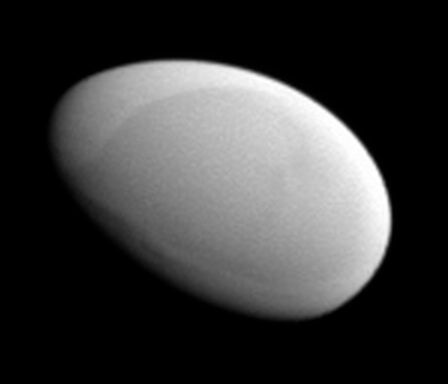The total number of lunar photographs of Saturn is increasing and you get a zoo of lunars. The Cassini spacecraft transmitted more lunar images to Earth than those transmitted by the Galileo spacecraft that photographed Jupiter. These moons are essentially flying mountains. Either they originate from the asteroid belt captured by the gravitational force of the gaseous planets or they are the products of collisions between moons already orbiting these planets.

The month we will review this time is particularly small and its name is Methone. Its diameter is 3 km. Let's imagine ourselves walking on it. In a few minutes we will pick it up on foot. Jumping is prohibited because very quickly you will find yourself detached from it and floating in space because its gravity is almost zero. What stands out is its shape. It looks like an egg and its full symmetry.
Mathon is between Enceladus and Miranda and its distance from Saturn is 194,000 km. It shows one side of Saturn and its density is 0.31. Very low density.
This moon was first detected by the Cassini spacecraft on June 1.6.2004, 20.5.2004. All they saw then was a point of light. Additional photographs were taken on 4000. The photographs were taken from a distance of 27 km and with a resolution of XNUMX meters per pixel. The photographs caused a surprise: the monthly had the shape of an egg. On a humorous note, one might ask, does Saturn lay eggs? Because of its location between two large moons, the gravitational forces of these moons affect its motion. Its orbit around Saturn causes it to oscillate as it orbits the planet.
Its photographed surface is smooth. Not a single groove can be seen in them, it is completely devoid of craters and is clear, except for a large dark spot that also has the shape of an egg for some reason. Why? With strong magnifications you can see that this dark spot is slightly submerged, tens of meters at the most. At one of the magnifications it is possible to distinguish points with different degrees of brightness. In some the brightness is weak and in some the brightness is strong. At a rough estimate, their diameter is tens of meters. What is the source of clarity? Maybe salt lumps like on the collapsed asteroid. Several points are arranged in the format of a graphic curve. It is possible that such points are also found in that part of the moon that was not photographed. A solution to this will be found in the future when a miniature off-road vehicle is placed on it.
It is not clear what the source of the darkness of the stain is. Perhaps it absorbed particles that were splashed from the moons between which it moved or from the rings. Because of its low density it is probably porous and contains water. A wild hypothesis is that it might be hollow - what's inside you can't tell. Because of its special shape it is difficult to treat it as just another block of rock. Maybe the solution is found in science fiction writers.
Sources
1. Methone: Overview
2. PIA14633: Gray Egg
3. Cassini Spots tiny moon. begins to tilt orbit"22.5.2012"
4. planetarygeomorphology.files.wordpress.com/2013/09/13_8_image_1_methone

One response
Perhaps the ovoid shape of the moon is due to the gravitational forces of the two large moons between which it moves?